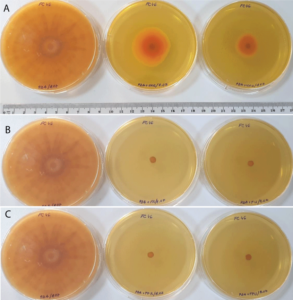The Influence of Low Pesticide Doses on Fusarium Molds
Veterinary Science – The Role of Low Pesticide Doses in Fusarium Control
In the realm of Veterinary Science, the agricultural sector significantly intersects with animal health through food safety and environmental factors. This intersection is especially apparent in addressing challenges posed by Fusarium molds and their mycotoxins, which impact both plant and animal health. This post explores the insights from recent studies on reducing pesticide usage while maintaining efficacy, focusing on the potential benefits for veterinary and agricultural practices.
Introduction
Fusariosis, caused by phytopathogenic molds of the Fusarium genus, presents a dual threat: economic losses in crop yield and quality and health risks due to mycotoxin contamination. The mycotoxins produced by Fusarium spp., such as deoxynivalenol and zearalenone, are hazardous to both humans and animals. In livestock, chronic exposure to Fusarium mycotoxins can lead to immunosuppression, liver and kidney damage, and reproductive issues(igmin226).
This blog highlights findings from the full research article and PDF version, focusing on reducing pesticide doses to mitigate environmental impact while maintaining effectiveness against Fusarium molds.
Key Concerns in Veterinary Science
- Mycotoxin Contamination:
Fusarium spp. contaminate cereals during cultivation and storage, producing mycotoxins that compromise food safety. The primary mycotoxins include fumonisins, trichothecenes, and zearalenone, all of which can severely affect animal health(igmin226). - Health Risks to Animals and Humans:
Chronic exposure to these toxins results in disorders ranging from immunosuppression to carcinogenic effects. Livestock consuming contaminated feed exhibit reduced productivity and increased vulnerability to diseases(igmin226). - Environmental Impact of Pesticides:
The excessive use of pesticides raises concerns about residue levels in animal feed and their broader ecological impact. Regulatory frameworks now emphasize reducing chemical use in agriculture to safeguard both human and animal health(igmin226).
Research Insights: Effectiveness of Reduced Pesticide Doses
Recent studies evaluated three commercial fungicides (CF1-NP, CF2-F, and CF3-FP) at reduced doses against Fusarium spp. The findings are promising for veterinary science, as they align with integrated pest management strategies:
- CF2-F and CF3-FP Fungicides:
These formulations demonstrated over 97.5% efficacy in inhibiting Fusarium culmorum at reduced doses. However, efficacy against Fusarium graminearum varied, indicating strain-specific responses(igmin226). - CF1-NP Fungicide:
Although less effective overall, CF1-NP still inhibited fungal growth significantly compared to untreated controls, even at reduced doses(igmin226). - Veterinary Science Implications:
Reduced pesticide usage lowers residue levels in feed crops, minimizing health risks to livestock and, by extension, humans consuming animal products.
Integrated Pest Management and Veterinary Science
- Crop Rotation and Biological Controls:
Strategies like crop rotation and using microbial biocontrol agents (e.g., Bacillus and Trichoderma spp.) can complement reduced chemical inputs(igmin226). - Food Safety Standards:
Reduced pesticide residues in animal feed ensure compliance with safety standards, reducing the risk of chronic illnesses in livestock and humans(igmin226). - Sustainability Goals:
The adoption of reduced-dose pesticides supports environmental conservation efforts, aligning with European Union’s Farm to Fork Strategy(igmin226).
Veterinary Science and Reduced Pesticide Usage
The integration of reduced-dose pesticide strategies into Veterinary Science practices has the following benefits:
- Improved Livestock Health: Reduced exposure to chemical residues minimizes the risk of chronic health issues.
- Economic Efficiency: Farmers benefit from lower pesticide costs and healthier livestock productivity.
- Ecological Benefits: The approach promotes biodiversity by limiting chemical impact on non-target organisms.
 Figure 1: Fusarium culmorum Fc46 fungal growth in control plates (left) compared to CF1-NP (a), CF2-F (b), and CF3-FP (c) pesticide treatments in reduced (center) and currently recommended dose (right) (after 10 days of incubation).
Figure 1: Fusarium culmorum Fc46 fungal growth in control plates (left) compared to CF1-NP (a), CF2-F (b), and CF3-FP (c) pesticide treatments in reduced (center) and currently recommended dose (right) (after 10 days of incubation). Figure 2: Fusarium graminearum Fg96 fungal growth in control plates (left) compared to CF1-NP treatments in reduced (center) and currently recommended dose (right), after 10 days of incubation.
Figure 2: Fusarium graminearum Fg96 fungal growth in control plates (left) compared to CF1-NP treatments in reduced (center) and currently recommended dose (right), after 10 days of incubation.
Conclusion
This study reinforces the importance of aligning agricultural practices with veterinary health standards by reducing pesticide usage. Such strategies contribute to food safety, animal welfare, and environmental conservation. As the veterinary science community continues to explore sustainable practices, integrating reduced-dose pesticides presents a viable path forward.
For a detailed exploration of this research, visit the HTML article or access the PDF version.
FAQs
- What is the impact of Fusarium molds on agriculture and veterinary science?
Fusarium molds significantly affect agriculture by reducing crop yields and contaminating cereals with mycotoxins, which pose risks to food safety. These toxins can cause severe health issues in livestock, including immunosuppression, liver damage, and reproductive disorders, thereby impacting both agriculture and veterinary science. - How effective are reduced pesticide doses in controlling Fusarium molds?
The study found that reduced doses of certain fungicides (CF2-F and CF3-FP) maintained over 97.5% efficacy against Fusarium culmorum strains. However, efficacy against Fusarium graminearum strains varied, indicating that reduced doses may not be universally effective. - Why is reducing pesticide usage important in veterinary science?
Reducing pesticide usage minimizes chemical residues in animal feed, decreasing the risk of chronic health issues in livestock. This approach also aligns with food safety regulations and ensures healthier animal products for human consumption. - What alternative strategies complement reduced pesticide usage?
Integrated pest management strategies, such as crop rotation, biological controls (e.g., Bacillus and Trichoderma spp.), and the use of tolerant crop cultivars, can enhance the effectiveness of reduced pesticide usage while promoting sustainability. - How does reducing pesticide use contribute to sustainability goals?
Lowering pesticide use reduces environmental pollution and promotes biodiversity by limiting harm to non-target organisms. This approach aligns with the European Union’s Farm to Fork Strategy, which emphasizes sustainable agriculture and food safety.
